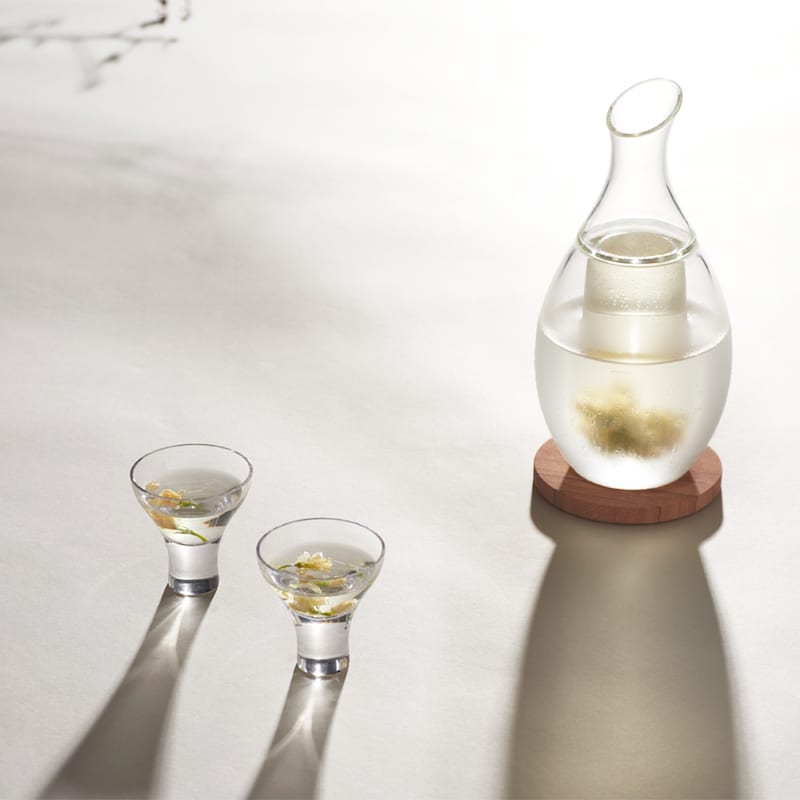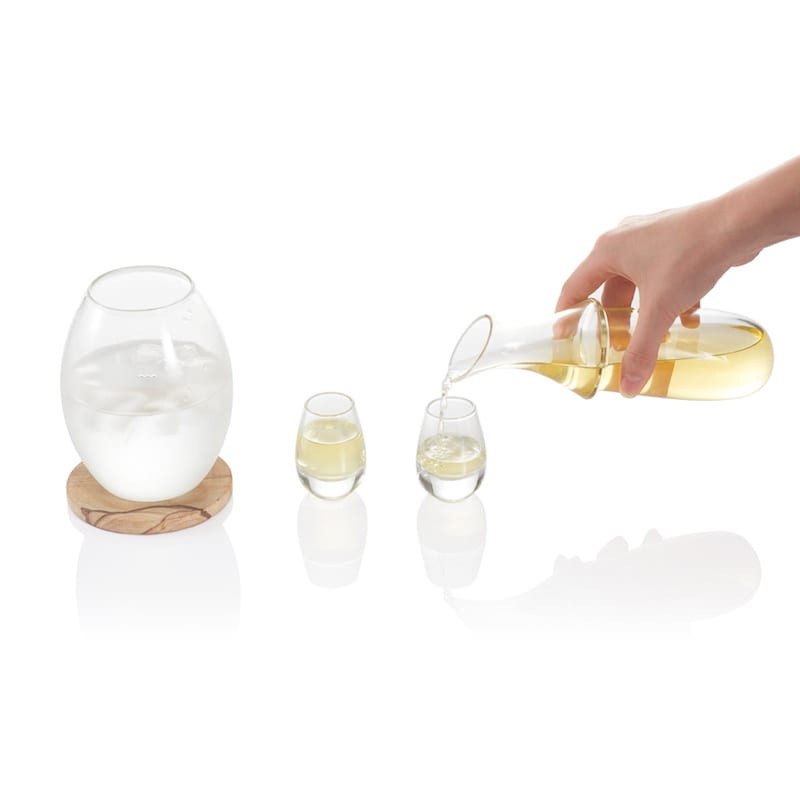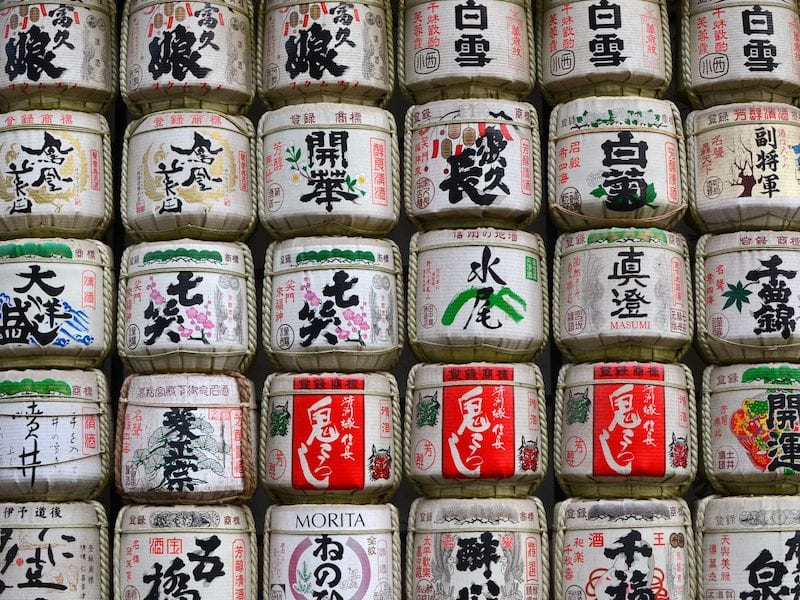Sponsored Post – ZENS, a modern teaware and home décor company, combines minimalist, smart design and traditional Asian elements to make beautiful dishware for your holiday entertaining and beyond. Be sure to enter the giveaway below!
We know how to serve wine, what to mix with our spirits and what temperature the beers should be, but what do you know about sake? Check out this guide to learn How to Serve Sake and enjoy it with casual meals or festive dinner parties.

Are you bored of the usual wine or beer options that you have at home? Let’s switch things up! We’ve been loving sake lately, but knowing how to serve the fermented Japanese rice beverage can be tricky if you aren’t familiar with it. We connected with ZENS, designers and makers of stylish, functional sake-ware to learn more about serving dos and don’ts.
How to Taste Sake
Just like a wine, when tasting a sake for the first time, we like to start by just looking at the drink. Is it clear or cloudy? What is the color like? Next, put your nose up to the glass and enjoy a nice, long whiff. Think about the aromas you smell and then dive in with a sip. The end of your sip might taste very different from how the drink tasted at the start. Recognize how it evolves on your tongue. Just like with wine or beer, tasting many different sakes is the best way to find ones that you enjoy.
There are a few different categories of sake and we encourage you to try an array. The label on the sake is often a food indicator of how sweet or dry it is. Lower numbers and into the negatives are going to be cloudier and contain more rice particles, meaning it is likely to be sweeter, while positive numbers more visually clear and have drier flavors. For example, a label that says -4 harder to see through and often sweeter and one that lists +4 will look like water in a glass and tends to have more savory characteristics. Not sure where to start? Here are a few varieties to begin with and terms you might see on the labels:
- Junmai: This means that it must be polished to a minimum of 70% seimaibuai. Seimaibuai is the percentage of rice remaining after polishing, the higher the number, the more rice that remains. This full-bodied sake is great served slightly chilled, at room temperature up to warm or body temperature. We wouldn’t recommend serving most junmais hot.
- Ginjo: This is a sake that tends to be fruity and must be polished to 60% seimaibuai. Serve this sake slightly chilled.
- Dai Ginjo: Dai Ginjo tends to be more a floral style of sake and is polished to a minimum of 50% seimaibuai and will contain the least amount of rice. This fragrant sake should be served just a touch cooler than room temperature.
- Unpasteurized or Nama. We like serving this sake at a crisp 40 degrees.
- Unfiltered or Nigori
- Undiluted or Genshu

The Best Serving Temperature for Sake
We firmly believe that you should serve sake at the temperature that you like best. BUT if you aren’t sure what temperature that is, let’s start with some basics and follow the traditional servings temperatures. From hot to chilled and every degree in between, each bottle of sake is a bit different when it comes to temperature. Generally speaking, sake made with a lower semaibuai should be served at cooler temperature so that the subtle nuances are not lost, while a sake with a higher semaibuai (75% or higher) is best served hot, to hide any imperfections. Much like wine, the flavors you can perceive from an individual sake will change with temperature. The lighter flavors become more apparent the colder a sake gets, and the bold flavors reclaim the drink as it warms to room temperature and beyond. Before you get to far though, think about the season. If it is a hot day, a chilled sake might be most refreshing to your palate, while a cold snowy evening may call for a warm sake to be served.
When all else fails, check the label. Many labels will list the temperature that the brewer recommends serving their sake at. If the label is not in english, check out this guide to translate.
We like pairing hot sake with heavier foods that have a lot of fat or are warm themselves, like hot pot. Chilled sake is great with raw fish, fatty or lean cuts. But be sure to experiment and see what works with your palate!
How to Warm a Sake
So you want to serve a sake warm, how do you do that? First, bring the sake to room temperature, then bring a saucepan of water to a boil and turn it off. Pour the sake into a large vessel and let it sit in the saucepan of hot water. Continuously try small sips of the sake to see if it is at the desired temperature. ZENS makes a beautiful sake vessel that allows you to fill the base with hot water to warm the sake. The same piece can also be filled with ice to quickly chill a sake in a stylish way. This smart vessels was a design award winner in 2016. Check it out here and a video about how to use it here.

What to Serve Sake In
Traditionally, sake is served out of porcelain or ceramic cups. Because sake usually has an ABV higher than 14%, you should pour amounts a bit less than what you usually pour for wine. It is recommended that a glass of sake should be around 6 ounces, but consumed over many small cupfuls.
ZENS has created a variety of sake glasses and cups. With a nod to Japanese traditions, their servings vessels are made of frosted glass to slightly obscure the sake so when it is getting close to empty, you are still focused on the conversation of those around you instead of topping up your glass and refilling.
Their sake glasses come with heavy bottoms and bases to encourage slow, thoughtful drinking of the sake as we enjoy the weight of a heavy glass in our hand, not necessarily a heavy pour.
When you are ready to pour the sake, Japanese tradition encourages you to pour for others and let someone around you pour your vessel of sake for you. The typically small vessels encourages you to fill your neighbor’s cup many times over the course of the meal. If you are hosting a dinner party, this is a great ice breaker and gets the conversation going around the table as your friends and family pour glasses for each other.

Storing Sake
We highly recommend only opening a bottle of sake that is the correct size for your group and that you plan to finish in that sitting. Unlike wine, sake does not keep well once it is opened and begin to oxidize quickly. When you aren’t drinking a bottle of sake, keep it in your fridge or in a cool, dark room. Light and heat are the two great enemies to a bottle of sake. Unlike wine, sake is not meant to age; try not to hold on to a bottle longer than 90 days. If it is a nama, make sure to always store at or below 40 degrees to prevent harmful bacteria.
ZENS is giving away a beautiful tea set. Enter below!
Kampai! Or cheers to your sake drinking adventures!












